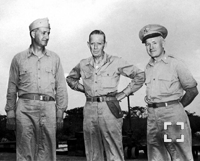Project Alberta

|
Also known as Project A, was a crucial segment of the Manhattan Project aimed at delivering the first nuclear weapons used in the atomic bombings of Hiroshima and Nagasaki during World War II. Established in March 1945, this project comprised 51 personnel from the United States Army, Navy, and civilian sectors, including one British scientist.
Its primary objectives included designing bomb shapes for aerial delivery, procuring and assembling the bombs, and supporting ballistic testing operations at Wendover Army Airfield in Utah, as well as modifying B-29 bombers to carry the nuclear weapons.
In March 1945, Project Alberta was formed by merging several groups within Parsons' Ordnance Division. Parsons led the project with Ramsey as his deputy and Commander Frederick Ashworth overseeing operations. The project included assembly teams for both the Fat Man and Little Boy bombs, along with specialized teams for observation, aircraft ordnance, and medical support. All personnel had volunteered for this critical mission.
The development of the 17-foot Thin Man bomb posed challenges for delivery, restricting it to specific aircraft like the British Avro Lancaster and the modified American Boeing B-29 Superfortress. Early tests revealed significant issues, prompting a comprehensive testing program. Further evaluations at Muroc Army Airfield and Wendover Army Air Field continued until the war's end in August 1945, with various groups contributing to the test program.
Establishing Operations on Tinian
In December 1944, plans were made to base operations in the Mariana Islands. After assessing various locations, Tinian was chosen for its suitable airfields. Construction of necessary facilities was overseen by Colonel Elmer E. Kirkpatrick. Four air-conditioned Quonset huts of a type normally used for bombsight repair were provided for laboratory and instrument work. There were five warehouses, a shop building, and assembly, ordnance and administrative buildings.
Ramsey overcame the problem of how to ship through the San Francisco Port of Embarkation. The port wanted a detailed list of what was being sent so it could track it to ensure delivery, but what needed to be shipped was still subject to last-minute change. He simply designated everything as a "bomb assembly kit". Three of these, one for Little Boy, one for Fat Man and one spare, were shipped to Tinian, which was now codenamed Destination O.
Despite lacking formal orders for an attack, Project Alberta aimed to have the Little Boy ready by August 1, 1945, followed by the Fat Man. During July, multiple combat missions against Japan were conducted using high-explosive Pumpkin bombs. Pumpkin bombs physical characteristics closely replicated those of the Fat Man plutonium bomb, with the same ballistic and handling characteristics. Several test assemblies were prepared, with the Little Boy assembly completed and ready for use by July 31, 1945. On July 25, orders for the bombing missions were issued, targeting Hiroshima, Kokura, Niigata, and Nagasaki, to be executed as weather permitted.
The Missions
Hiroshima
On August 6, 1945, the Enola Gay took off for Hiroshima, carrying the Little Boy bomb. Four other members of Project Alberta flew on the Hiroshima mission. Luis Alvarez, Harold Agnew and Lawrence H. Johnston were on the instrument plane The Great Artiste, equipped with "Bangometer" canisters to measure the force of the blast. Bernard Waldman was the camera operator on the observation aircraft. He was equipped with a special high-speed Fastax movie camera with six seconds of film in order to record the blast. Waldman forgot to open the camera shutter, and no film was exposed.
The only footage of the mushroom cloud was taken by Harold Agnew while Robert "Bob" Caron took the definitive photograph of the cloud from the tail gunner position of the "Enola Gay.
Once armed, the weapon was extremely unsafe, with a crash, fire or immersion in water causing a full yield explosion. For this reason 'Deke' Parsons, serving as the weaponeer managed the arming of the bomb during the flight, barehanded in sub-zero temeratures.
The mission proceeded as planned, with the bomb dropped at 8:15 AM, detonating 580m above Hiroshima with a yield of 15 kilotons. Approximately 70,000 people were killed as a direct result of the blast, with a similar number injured.
Nagasaki
Following the Hiroshima bombing, discussions were held regarding the next target. The Fat Man bomb was prepared for a mission on August 9, 1945. Robert Serber was supposed to be on board but was left behind by the aircraft commander as he had forgotten his parachute. Since he was the only crew member who knew how to operate the high-speed camera, the whole point of the aircraft's mission, another crew member had to be instructed by radio from Tinian on its use.
The plutonium bomb did not require arming in flight, but did have its safeties removed 30 minutes after the 03:45 takeoff when Bockscar reached a 1,500m altitude.
Despite initial complications, including aircraft malfunctions and weather issues, Bockscar successfully dropped the Fat Man on Nagasaki after diverting from its original target. The weapon detonated 503m above the city with a yield of 21 kilotons. An estimated 40,000 people were killed outright by the blast, with about 25,000 injured.
Conclusion and Aftermath
Post-bombing, Project Alberta continued to assess the damage and prepare for further operations. However, Japan's surrender on August 15, 1945, marked the end of the project. The remaining personnel began packing up, and unused bomb assemblies were returned to Los Alamos. Project Alberta was officially discontinued on September 7, 1945, with many personnel transferred to the new Z Division.
|





